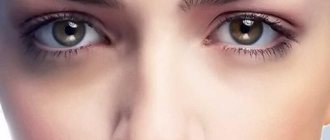Etiology (cause) of the appearance of dark circles under the eyes.
The causes of dark circles under the eyes can be divided into three groups:
- Lifestyle influence
- Diseases of internal organs
- Heredity
Let's look at the above groups in more detail.
Lifestyle influence
The most common reasons include the first group. An unhealthy lifestyle includes: regular lack of sleep, unbalanced diet, lack of vitamins, insufficient drinking regimen, bad habits, frequent stress, excessive sun exposure, as well as work that involves sitting for many hours at the monitor. From this we can conclude that many of us, unfortunately, fall into this group. However, the causes of this group are the easiest to deal with; they are all reversible and can be easily corrected.
Diseases of internal organs
When influenced by the second group of reasons, dark circles are only an external manifestation of internal health problems.
Dark circles are formed when venous and lymphatic outflow is impaired, which occurs when there is insufficient blood supply and oxygen deficiency. This condition is called ischemia and hypoxia. As a result, metabolic disorders and insufficient supply of nutrients occur. Thus, dark circles under the eyes are often found in people suffering from heart failure, ischemic heart disease and other cardiovascular diseases, as well as bronchopulmonary diseases (chronic bronchitis, fibrosing alveolitis, sarcoidosis, tuberculosis).
When the level of hemoglobin and red blood cells decreases (anemia), dark circles under the eyes may occur. The blood does not bring the required amount of oxygen to the tissues. Reduced hemoglobin accumulates and the blood acquires a dark tint. This is what causes the discoloration of the skin around the eyes.
In diseases of the hepatobiliary system (cholesterolism, cholecystitis), the content of the bilirubin pigment in the blood increases. This may be the cause of pigmentation of the skin around the eyes. In this case, the skin acquires a yellowish-brown tint.
With diseases of the thyroid gland, in particular with hypothyroidism, bruises under the eyes occur. This happens due to a lack of iodine in the body. In addition to dark circles, patients are concerned about lethargy, drowsiness, deterioration of memory and attention, intolerance to cold and heat, and hair loss.
In diseases of the nasopharynx (chronic tonsillitis, sinusitis, sinusitis, adenoiditis, etc.), the vessels dilate, they become filled with blood and, as a result, blueness under the eyes occurs.
All acute infectious diseases accompanied by a rise in high temperature lead to intoxication by metabolic products of pathogenic microorganisms. At the same time, the pH of the blood changes with a shift towards increasing acidity. Acidosis, in turn, leads to increased vascular permeability and dilation. With intoxication syndrome, dehydration occurs. Thus, through dry, thin, dehydrated skin, dilated capillaries become more visible, creating the effect of dark circles.
Diseases of the kidneys and adrenal glands lead to increased pigmentation in the periorbital zone. In chronic adrenal insufficiency (Addison's disease), in addition to pigmentation of the skin around the eyes, pigmentation intensifies in the natural folds of the skin (palms, groin) and in places where clothing rubs (neck, lower back). In case of kidney diseases (pyelonephritis, glomerulonephritis, etc.), bruises under the eyes appear during exacerbation of the disease and are accompanied by impaired excretory function of the kidneys.
If there is an imbalance of female sex hormones (estrogen, progesterone), especially during periods of hormonal changes (pregnancy, menopause), there is a risk of hyperpigmentation around the eyes.
Various inflammatory diseases of the eyes (conjunctivitis, iridocyclitis, etc.) are accompanied by swelling and increased capillary permeability, which also makes them more noticeable, as if “translucent”.
With a condition such as vegetative-vascular dystonia (it is not a disease, it is a polyetiological syndrome), dark circles under the eyes are also often found. In this case, a person suffers from cardialgia, asthenia, neurotic disorders, headaches, sleep disturbances, dizziness, respiratory disorders, palpitations, cold hands and feet, trembling hands, swelling of tissues, a feeling of heat in the face, fainting. This list can be continued indefinitely; various combinations of the above disorders may occur.
The greatest accumulation of mast cells was recorded in the periorbital zone, which explains the reactivity of the skin around the eyes and the frequent occurrence of allergic reactions. In allergic conditions (allergic rhinitis, hay fever, etc.), dilation of blood vessels occurs with an increase in their permeability, which gives the skin around the eyes a dark tint.
Heredity
Well, and finally, the third group of reasons is due to heredity. This group includes those who have no problems with proper lifestyle and health. For them, hyperpigmentation under the eyes in the form of dark circles is a relative norm. An interesting fact is that those with dark or very dry skin are more likely to suffer from this deficiency than others.
It should be noted that when taking oral contraceptives, sulfonamides, tetracyclines, there is also a possibility of hyperpigmentation of the skin around the eyes.
All of the above conditions (improper lifestyle, diseases of internal organs, genetic predisposition) are aggravated by excessive exposure to ultraviolet radiation. Hyperpigmentation becomes more persistent and difficult to treat.
Causes
There are a huge number of factors for the appearance of dark circles, ranging from the simplest ones, which do not affect the functions and systems of the body, to a direct indication that dangerous diseases are progressing.
Among the most common is a violation of the permeability of capillary walls. Considering that there are quite a lot of them in thin skin, aesthetic defects become very noticeable. And the thinner the skin, the stronger the bruises will appear. The following factors can affect the blood circulation under the eyes:
- working at a computer, reading for long periods of time, and other painstaking tasks that tire the eyesight;
- lack of rest and sleep;
- lack of walks in the fresh air, lack of oxygen;
- eating junk food, drinking alcohol, smoking;
- age-related changes, during which the dermal layer becomes thinner and ceases to adequately hide the vessels;
- low-quality cosmetic compositions;
- exposure to ultraviolet radiation, reducing the amount of subcutaneous fat;
- flabbiness;
- little adipose tissue, thinning of the dermis layer;
- genetics, increased pigmentation, production of melanocytes in the eye area;
- negative effects of certain medications;
- incorrectly selected glasses and contact lenses.
There are a lot of everyday reasons, but they can be easily compensated for. By eliminating such factors and using the right skin care products, the skin quickly becomes denser and the tone is evened out.
Diagnosis of the body's condition
In order to exclude pathology of internal organs, it is necessary to undergo a comprehensive laboratory and instrumental examination.
- General blood analysis
- Blood chemistry
- Test for thyroid hormones (TSH, free T4)
- Test for adrenal hormones (cortisol, ACTH)
- Test for sex hormones (estrogen, progesterone)
- Ultrasound of the abdominal organs
- Ultrasound of the pelvic organs
- Ultrasound of the kidneys, adrenal glands and retroperitoneum
- Ultrasound of the thyroid gland
- ECG
- EchoCG
- EGDS
- X-ray of the chest organs
- Bronchoscopy
- Consultations with specialists (cardiologist, gastroenterologist, otolaryngologist, endocrinologist, gynecologist, ophthalmologist, urologist, allergist)
What diseases cause
An unhealthy lifestyle, taking medications and prolonged exposure to the sun are not always the main primary sources of manifestations. It happens that this is the first bell signaling that there are problems in the body. These include both functional and pathological changes, including:
- kidney and liver diseases, among additional symptoms: jaundice, heartburn, nausea, vomiting, heaviness in the gastrointestinal tract, problems with urination;
- metabolic disorders, lack of vitamins, manifested in the form of drowsiness, apathy, and fatigue;
- diseases of the cardiovascular system can be determined if, in addition to blueness, dizziness, shortness of breath, and rhythm disturbances are observed;
- chronic fatigue in people with a constant desire to sleep, mood swings, frequent colds, headaches and poor sleep;
- endocrinological are expressed in an excess or deficiency of important hormones, nervousness, sweating;
- insufficient or excessive hydration of the face, in the form of oily shine or flaking, pallor or rosacea, etc.
If additional symptoms appear in combination with blue discoloration in the lower eyelid, it is important not to delay and consult a specialist. Most problems are solvable and easily treated with medication, and after eliminating the root cause, the skin restoration complex will help you quickly achieve a healthy appearance without the need to use dense layers of foundation and powder.
Treatment
If internal diseases are excluded, then we are talking about a cosmetic defect, which is a consequence of an unhealthy lifestyle and genetic predisposition. The most popular and effective treatments for dark circles under the eyes are as follows.
- Mesotherapy Preference is given to meso-cocktails containing ascorbic, phytic and kojic acids, and arbutin. A course of 6-10 procedures with an interval of 1 week.
- Bioreparation with vitamin C The combination of hyaluronic acid and vitamin C effectively moisturizes and brightens the skin around the eyes. A course of 2-4 procedures with an interval of 2 weeks.
- Plasmolifting By restoring metabolic processes, normalizing tissue respiration, and improving microcirculation, local skin immunity is activated. A course of 4-6 procedures with an interval of 1 week.
- Biorevitalization The skin under the eyes reacts especially acutely to dehydration and often looks unaesthetic due to dryness, creating the effect of “tired eyes”. A course of 2-4 procedures with an interval of 2 weeks.
- Contour plastic With closely spaced, “translucent” vessels, filler creates an additional layer between the skin and the underlying vessels, thereby making them less noticeable. Additionally, the effect of leveling the nasolacrimal groove is achieved.
- Laser peeling The essence of laser resurfacing is to remove the upper layers of the skin, its renewal and rejuvenation. A course of 2-5 procedures with an interval of 1 month.
Photos "before and after"
SMAS face and neck lift, blepharoplasty of the upper and lower eyelids. Surgeon: Iskornev A.A.
Done by Iskornev A.A.
Done by Melnikov D.V.
Cosmetic products for skin care around the eyes
Cosmetic products for skin care around the eyes
Today, the cosmetology industry produces many products to care for the skin around the eyes. One of the leaders among them is Unidermix - an eyelid fluid based on silk proteins and mint oil extracts. Unidermix has a pronounced lymphatic drainage effect, moisturizes the skin, smoothes out fine expression wrinkles and delicately eliminates dark circles.











